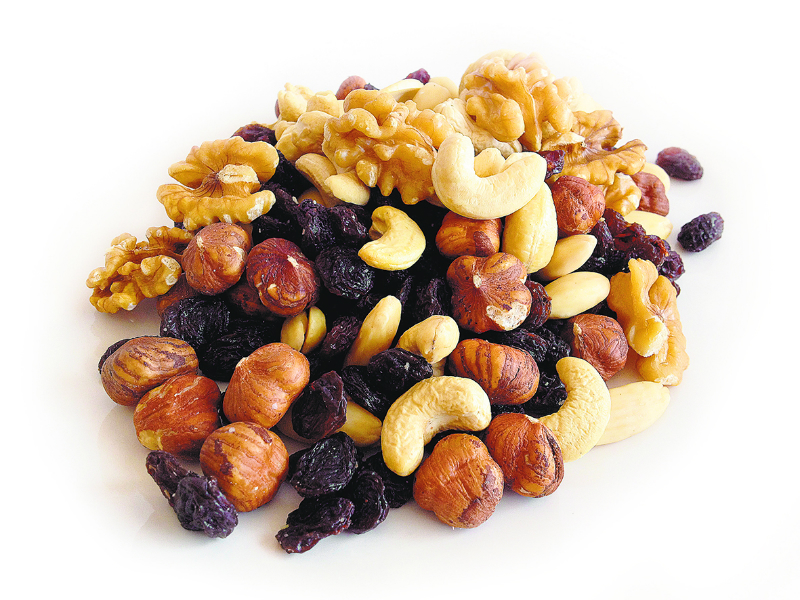What Passover seder symbol is found in the traditions of all Jewish communities, but is not mentioned in the biblical passage that enjoins us to eat the paschal offering, matzah and bitter herbs? Haroset.
We define haroset loosely as a paste of fruit, spices, wine and matzah meal that’s symbolic of the mortar used by the Hebrews when they were slaves in Egypt.
The word is of unknown origin, but may come from the word “heres,” meaning clay, because of its colour. The custom of eating haroset is thought to have come from the time of the Babylonians, who dipped food in relishes or sauces to add flavour.
Different versions of haroset appear in the Ashkenazic and Sephardic traditions.
The New York Times Passover Cookbook, edited by Linda Amster, says that the Iraqi version is one of the oldest and most time-consuming recipes, dating back to the Babylonian exile of 579 BCE. Made into a jam from dates, grapes, pomegranate and honey, it was a sweetener in the ancient world and is still used by Iraqi, Burmese, Syrian and Indian Jews.
The Talmud says that haroset must be sharp in taste and similar to clay in substance and colour, thus the recipe varies among different communities.
Ashkenazim tend to use apples, chopped almonds (or other nuts), cinnamon, red wine and sometimes matzah meal. Sephardim and those from Middle Eastern countries tend to use fruits that grew in the Land of Israel in biblical times, such as grapes, figs, dates, almonds and pomegranates. Israelis often turn haroset into a dessert by adding bananas, dates, orange juice and sugar.
Because the maror or bitter herb is so strong, some say the real purpose of haroset is to allay the bitterness. As part of the ritual seder, the haroset and maror are placed between matzot to make a sandwich, which is said to have been invented by Rabbi Hillel in the first century CE, hence the name, Hillel’s sandwich.
Different Jewish communities have variations on the ingredients. Jews from the Island of Rhodes use dates, walnuts, ginger and sweet wine. The Jews of Salonika, Greece, add raisins. Other Greek Jews use walnuts, almonds, pine nuts, raisins, cinnamon, cloves and red wine, and spread it thickly on matzah. Turkish Jews include oranges.
Moroccan Jews sometimes make haroset paste and roll it into balls. This is a legacy from the Jews of medieval Spain, who made the balls of apples, dried fruit, almonds, cooked chestnuts, sugar and cinnamon, and then drizzled the balls with white vinegar before serving.
The Jews of Venice use chestnut paste, dates, figs, poppy seeds, walnuts, pine nuts, orange peel, dried apricots, raisins, brandy and honey.
The Jews of Bukhara, Uzbekistan, use almonds, dates, raisins, apples and wine.
Egyptian haroset contains dates, nuts, bananas, apples, wine, cinnamon and pomegranate seeds.
READ: DELICIOUS CHICKEN RECIPES FOR PASSOVER
Instead of haroset as we know it, some Iraqi Jews use a date syrup call halek – which is made by boiling dates, straining the liquid and then reducing it over a low flame until thick – and sprinkling chopped nuts on top of it.
In Holland, they make a chunky mixture with more apples and less nuts, combined with cinnamon, sugar, raisins and sweet wine. Jews from Surinam, in Dutch Guiana, use seven fruits and coconut.
Following the edict to have a sharp taste, Persian Jews use dates, pistachio nuts, almonds, raisins, apples, oranges, bananas, pomegranate seeds, sweet wine, cloves, cardamom, cinnamon, vinegar and black pepper.
Likewise, Yemenite Jews use dates, raisins, almonds, nuts, figs, dates, sesame seeds, apples, pomegranate seeds, grape juice, ginger, cinnamon, cardamom, cloves and black pepper.
Jews from Afghanistan pound haroset in a mortar with a pestle and use walnuts, hazelnuts, almonds, apples, sweet wine, pomegranate seeds, dates and black pepper.
However you make haroset, be inventive and make several different kinds to serve.
My Mom’s Haroset
o 2 apples, chopped
o 75 ml (1/3 cup) ground nuts
o 1.25 ml (1/4 tsp) cinnamon
o 15 ml (1 tbsp) honey
o 30 ml (2 tbsp) sweet red wine
Place chopped apples in a bowl. Add nuts, cinnamon and honey and mix until smooth.
Add wine and mix well.
Makes 6 servings.
My Sephardic Haroset
o 250 ml (1 cup) chopped dates
o 125 ml (1/2 cup) raisins
o 1 chopped apple
o 125 ml (1/2 cup) finely chopped nuts
o 5 ml (1 tsp) ginger
o 60 ml (1/4 cup) red wine
Combine all ingredients.
Yields 500 ml (2 cups).
Sephardic Haroset
o 250 ml (1 cup) chopped walnuts
o 60 ml (1/4 cup) chopped almonds
o 125 ml (1/2 cup) raisins
o 125 ml (1/2 cup) chopped dates
o 60 ml (1/4 cup) red wine
o 30 ml (2 tbsp) lemon juice
o 0.5 ml (1/8 tsp) cinnamon
o apricot halves
Combine walnuts, almonds, raisins, dates, wine, lemon juice and cinnamon.
Form into balls.
Spoon onto apricot halves.
Sabra Haroset
o 2 peeled and cored apples
o 6 peeled bananas
o 1 lemon, juiced
o 1 orange, juiced
o 20 pitted dates
o 250 ml (1 cup) peanuts
o 250 ml (1 cup) dry red wine
o matzah meal, as needed
o 10 ml (2 tsp) cinnamon
o sugar, to taste
Put fruit and nuts though a grinder (or blender or food processor).
Add wine, lemon juice and orange juice.
Add enough matzah meal to form the consistency you want.
Mix in cinnamon and sugar.
